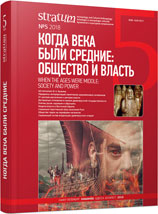Социальная, хронологическая группа или культурный тип: парадоксы интерпретаций памятников раннесредневековых кочевников Восточной Европы (VI — начало VIII вв.)
Social, Chronological Group or Cultural Type: paradoxes in interpretations of the early nomadic sites in Eastern Europe (6th — early 8th centuries AD)
Author(s): Oleksii V. KomarSubject(s): History, Archaeology, Middle Ages, 6th to 12th Centuries
Published by: Издательский дом Stratum, Университет «Высшая антропологическая школа»
Keywords: Pereshchepina culture; Sivashovka type; archaeological complex; social stratification; chronology; Northern Black Sea region;
Summary/Abstract: Interpretation of the results of the burials grouping by using statistical and typological methods is associated with difficulties in the case of an analysis of individual nomadic funerary and ritual complexes, scattered on a vast territory. Long lasting discussion about the correlation of burial groups of the Eastern European nomads of the 6th — early 8th century demonstrates what variety of versions can be used to explain the differences between groups: chronological, social, cultural, ethnic, or their combinations. The sum of differences between barrow burials of the Sivashovka type and rich complexes of the Pereschepina circle is very significant. But all versions, except social, cause a serious paradox — existence of an “ultra-rich” cultural group of nomads or the highest nobility without any lower social strata. The second problem is the location of the richest complexes of the Pereshchepina circle on the southern outskirts of the forest-steppe, in the area of the settled population of the Penkovka culture. These facts, in combination with hoarding activity within the range of the Penkovka culture, and the cessation of its existence, is interpreted as evidence of an invasion of nomads. But they are also considered as a testimony of the symbiosis of the Slavs and nomads, up to the creation of the Slavic-nomadic state. The current situations can be mainly explained by limitations of the source base, imperfection of traditional methods and weak use of modern natural scientific methods.
Journal: Stratum plus. Археология и культурная антропология
- Issue Year: 2018
- Issue No: 5
- Page Range: 117-128
- Page Count: 12
- Language: Russian
- Content File-PDF

